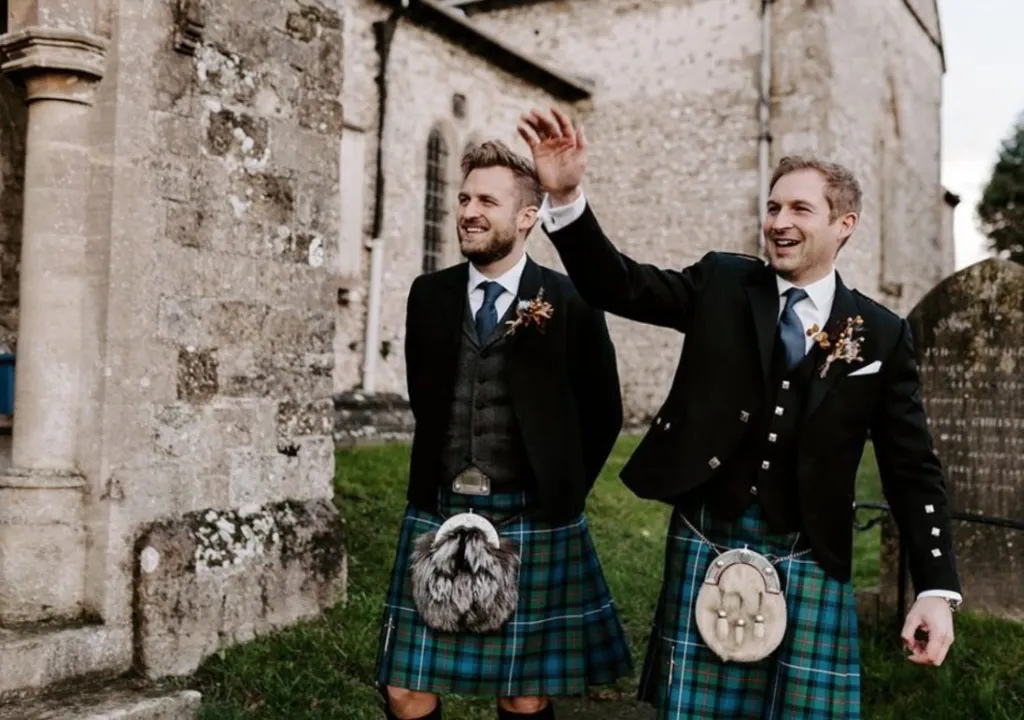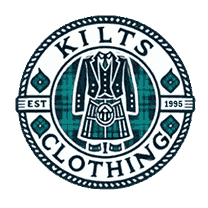Different Types of Kilt Jackets: A Comprehensive Guide

Kilts are a timeless symbol of Scottish heritage, cherished for centuries as both practical garments and fashionable attire and a main part of kilt accessories. Originally designed for functionality, kilts have transformed into a distinct fashion statement, embodying Scottish pride and tradition.
However, the kilt jacket plays a crucial role in completing the traditional ensemble. It not only enhances the kilt’s appearance but also reflects the wearer’s style and the occasion’s formality. From the elegant Prince Charlie to the versatile Argyll, each type of kilt jacket offers unique features and fits different events and personal tastes.
Understanding the various kilt jackets and their appropriate uses ensures that you can select the right one to match any occasion, whether formal or casual. Embracing these garments allows for a deeper connection with Scottish heritage and a polished presentation of one of Scotland’s most iconic pieces of attire.
The Prince Charlie Jacket
The Prince Charlie jacket is the most formal and recognized of all kilt jackets. Named after Prince Charles Edward Stuart, this jacket is often worn for evening events and formal occasions and a special part of kilt accessories. Here’s an in-depth look at this classic piece:
Design and Features:
- Cut and Style: The Prince Charlie jacket features a short, waist-length cut with a fitted silhouette. It typically has a high collar and is designed to be worn with a waistcoat.
- Fabric: It is usually made from black wool or a blend of wool and polyester, making it both stylish and durable.
- Buttons and Trimmings: The jacket often comes with ornate buttons, which may feature traditional Scottish motifs such as thistles or crests. It may also include epaulets on the shoulders for added decoration.
When to Wear:
- Occasions: The Prince Charlie is ideal for black-tie events, weddings, and formal dinners.
- Accessories: It is often paired with a black silk bow tie, a waistcoat, and a sporran. The overall look is completed with polished shoes and formal dress socks.
Care and Maintenance:
- Cleaning: Dry cleaning is recommended to maintain the jacket’s appearance.
- Storage: Store it in a cool, dry place, preferably in a garment bag to protect it from dust and damage.
Wallace Kilt Jacket
The Wallace kilt jacket is a distinguished piece of Scottish traditional wear. It is named after the legendary figure William Wallace, a symbol of Scottish freedom and bravery. This jacket offers a blend of historic elegance and contemporary style, making it a popular choice for those seeking a classic yet versatile kilt ensemble.
Design and Features
- Cut and Style: The Wallace kilt jacket features a tailored, waist-length cut that strikes a balance between formality and comfort. It typically has a fitted silhouette with a structured design, including a high collar and a slightly padded chest for a sharp, defined look.
- Fabric: Crafted from high-quality wool or tweed, the Wallace jacket often comes in various traditional patterns and colors, such as dark navy, charcoal, or classic grey. The fabric choice not only provides durability but also enhances the jacket’s elegance.
- Buttons and Trimmings: This jacket often features decorative buttons with Scottish motifs, such as thistles or crests, adding a touch of heritage. The trimmings are usually subtle, focusing on clean lines and a refined appearance.
When to Wear
- Occasions: The Wallace kilt jacket is versatile enough for both formal and semi-formal occasions. It is suitable for weddings, evening events, and traditional Scottish ceremonies. Its classic design also makes it appropriate for more casual gatherings where a touch of sophistication is desired.
- Accessories: This jacket pairs well with a variety of accessories, including a waistcoat, sporran, and cravat or tie. For formal events, it can be complemented with a bow tie, while for a more relaxed look, a standard tie or even a tartan sash can be used.
Care and Maintenance
- Cleaning: To maintain the jacket’s appearance and longevity, dry cleaning is recommended. Regular cleaning will help preserve the fabric’s texture and color.
- Storage: Store the Wallace kilt jacket in a cool, dry place, ideally in a breathable garment bag to protect it from dust and maintain its shape.
The Argyll Jacket
The Argyll jacket is a versatile piece that bridges the gap between formal and casual wear. It is named after the Argyll region in Scotland and is a popular choice for many different occasions.
Design and Features:
- Cut and Style: This jacket has a longer cut than the Prince Charlie, usually reaching the hips. It has a more relaxed fit, which makes it suitable for a range of events.
- Fabric: Commonly made from tweed or wool, the Argyll jacket can come in various colors and patterns.
- Buttons and Trimmings: The jacket often features plain or subtly decorated buttons and may have a semi-formal look with fewer embellishments than Prince Charlie.
When to Wear:
- Occasions: The Argyll jacket is versatile enough for both formal and semi-formal events, including business functions, less formal weddings, and community gatherings.
- Accessories: It pairs well with a range of accessories, including different styles of ties, a waistcoat, and a variety of sporrans.
Care and Maintenance:
- Cleaning: Like Prince Charlie, dry cleaning is best for the Argyll jacket.
- Storage: Keep it in a garment bag to avoid dust and ensure it retains its shape.
- The Braemar Jacket
The Braemar jacket, named after the famous Braemar Gathering in Scotland, is a less formal option that combines comfort with traditional style. It is an excellent choice for those who prefer a more relaxed look without sacrificing elegance.
Design and Features:
- Cut and Style: This jacket features a more relaxed fit and a slightly longer cut that reaches the hip or lower. Its soft, unstructured design offers a comfortable fit.
- Fabric: Typically made from tweed or wool, the Braemar jacket often includes subtle patterns and earthy tones.
- Buttons and Trimmings: It usually features plain buttons and minimal embellishments, focusing on simplicity and comfort.
When to Wear:
- Occasions: It is ideal for outdoor events, casual gatherings, and informal occasions. It is also suitable for day-to-day wear if you wish to maintain a traditional Scottish look.
- Accessories: For a relaxed look, the Braemar jacket is often worn with a casual sporran and a variety of neckwear, including ties or even scarves.
Care and Maintenance:
- Cleaning: Regular brushing and occasional dry cleaning will help maintain its appearance.
- Storage: Store in a cool, dry place, and consider using a breathable garment bag.
The Highland Jacket
The Highland jacket is a classic choice for those who want to embrace the traditional Scottish look while enjoying a bit more flexibility in their attire. It combines elements of both formal and casual kilt jackets.
Design and Features:
- Cut and Style: This jacket typically has a longer cut and a more structured design than the Braemar but is less formal than the Prince Charlie.
- Fabric: Made from high-quality wool or tweed, it can come in various colors and patterns that reflect Scottish heritage.
- Buttons and Trimmings: It often features traditional Scottish buttons and may include decorative elements such as epaulets or shoulder patches.
When to Wear:
- Occasions: It is suitable for a wide range of events, including formal gatherings, semi-formal occasions, and traditional Scottish celebrations.
- Accessories: Pairs well with a variety of sporrans, ties, and even a waistcoat for a more polished look.
Care and Maintenance:
- Cleaning: Dry cleaning is recommended to maintain its shape and fabric quality.
- Storage: Keep it in a garment bag to protect it from dust and preserve its appearance.
The Camo Jacket
The Camo jacket is a modern twist on the traditional kilt jacket, incorporating elements of military and outdoor gear into the classic Scottish attire. This style has gained popularity in recent years, particularly among younger generations.
Design and Features:
- Cut and Style: The Camo jacket often features a more casual, rugged design with a longer cut and practical elements such as pockets.
- Fabric: Typically made from durable materials such as camo-patterned polyester or a blend of synthetic fibers.
- Buttons and Trimmings: It may include practical buttons and minimal decorative elements, focusing more on function than formality.
When to Wear:
- Occasions: Ideal for outdoor activities, casual events, and Scottish-themed gatherings with a modern twist.
- Accessories: It pairs well with a variety of casual accessories and sporrans, often opting for a more practical approach.
Care and Maintenance:
- Cleaning: Machine washable or easy-to-clean materials make this jacket low-maintenance.
- Storage: Store in a dry place and avoid exposure to extreme temperatures.
Conclusion
The kilt jacket is a crucial component of traditional Scottish kilt accessories, with various styles catering to different occasions and personal preferences. Whether you opt for the formal elegance of Prince Charlie, the versatile Argyll, the relaxed Braemar, the classic Highland, or the modern Camo jacket, each piece brings its unique touch to the kilt ensemble. Understanding the different types of kilt jackets and their appropriate uses ensures you can select the right jacket for any occasion, allowing you to embrace Scottish heritage with style and confidence.
FAQs
Kilt jackets are typically made from high-quality wool or tweed. These fabrics provide durability, warmth, and a classic appearance, with some jackets also incorporating blends of synthetic fibers for added comfort and versatility.
When wearing a kilt, choose from several types of jackets based on the occasion:
- Prince Charlie Jacket – Ideal for formal events, featuring a waist-length cut and ornate details.
- Argyll Jacket – Versatile for both formal and semi-formal occasions, offering a slightly relaxed fit.
- Braemar Jacket – Suited for casual or outdoor events, with a more relaxed and comfortable design.
- Highland Jacket – A classic option that bridges formal and casual styles, providing a traditional look.
- Camo Jacket – A modern twist, perfect for casual or themed events with a rugged appearance.
The primary differences between a kilt jacket and a suit jacket are:
Design and Fit: Kilt jackets, such as the Prince Charlie or Argyll, are tailored specifically to complement the kilt, often featuring shorter cuts, distinctive Scottish details, and high collars. Suit jackets are designed for standard trousers and usually have a more uniform length and traditional lapels.
Fabric and Style: Kilt jackets are typically made from wool or tweed with Scottish motifs, while suit jackets are often crafted from a variety of materials like wool, cotton, or synthetic blends and come in a range of colors and patterns. Kilt jackets focus on traditional Scottish aesthetics, whereas suit jackets emphasize a broader range of formal and business styles.
A kilt jacket should fit as follows:
Shoulders: The jacket should sit comfortably on the shoulders without any bulging or sagging. The shoulder seams should align with the natural shoulder line.
Chest and Waist: It should fit snugly but allow enough room for movement. The jacket should taper slightly at the waist, creating a fitted silhouette that complements the kilt.
Sleeves: Sleeves should end just above the wrist bone, allowing for a shirt cuff to be visible. They should not be too tight or too loose.
Length: The jacket should typically fall to the top of the hip or slightly below, depending on the style. It should not extend too far down or ride up excessively.
Overall, the fit should balance comfort with a polished, tailored appearance, ensuring the jacket complements the kilt and enhances the overall look.



